Electric Motorcycle vs Gas Motorcycle: A Comprehensive Comparison
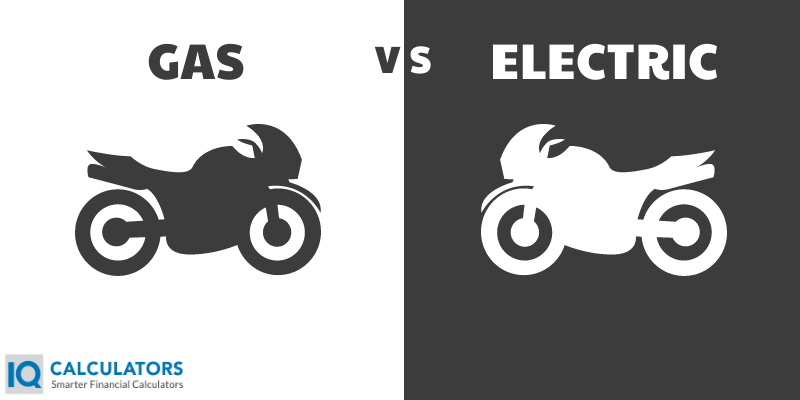
Electric motorcycles, much like electric cars, have become trendy in recent years. Most people automatically think that they will save enough money on gas to make it worth the purchase. Or they want to care for the environment and go green. In this article, we will do a high-level evaluation to let you examine the pros and cons of purchasing an electric bike. There's probably some obvious ones you've considered, as well as ones that might surprise you.
Electric Motorcycle Sales Projections
Electric motorcycles are growing in popularity worldwide for many of the reasons we mention below. Electric motorcycle demand is projected to grow at a 4.2 percent compounded annual growth rate. In 2018, unit sales worldwide were 18 million and expected to grow to 23 million by the year 2024.
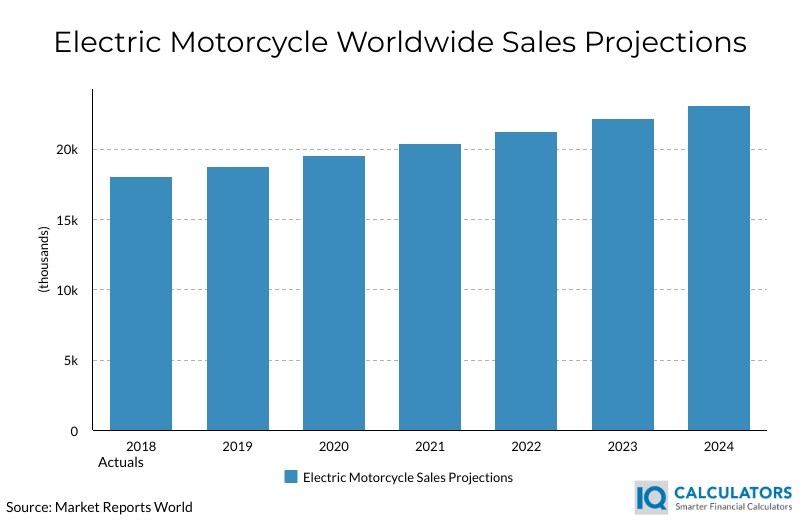
Electric Motorcycle Pros
Easy(er) Maintenance
Maintenance for an electric bike involves changing a drive belt at prescribed mileage and changing tires and brakes as needed. There just aren't that many maintenance items on an electric motorcycle.
Maintenance for a gas bike involves changing the oil, changing the battery, and changing other various fluids on which your motorcycle depends. These gas-powered maintenance items are in addition to the items already mentioned with electric bikes.
No Warmup Needed
Electric bikes can be ridden immediately after starting. There's no need to allow warmup time to reduce wear and tear on the bike like a gas-powered bike.
Save Money on Gas
Saving money on gas is a big one. For many, this is the number one reason people purchase an electric bike. Similarly, this is the reason most people buy motorcycles in the first place, whether gas or electric, is to spend less on gas. Purchasing an electric bike takes these energy savings to the extreme. Later on, we will look at this more in-depth with a cost-benefit analysis.
Less Likely To Overheat
With an electric motor, there's less friction since the engine doesn't have as many moving parts, causing friction. However, an electric motor can overheat as well if a vent gets blocked, and it isn't getting enough ventilation. There are other potential causes, but again, it is less likely that overheating takes place.
Electric Vehicle Rebate
Federal tax incentives are granted on a company by company basis. Each electric vehicle company has a specific period where federal tax incentives are offered and phase out. However, each state potentially offers its own incentives to purchase an electric vehicle. The US Department of Energy has an excellent search tool that lets you see what tax incentives are available in your state.
Faster Acceleration
Although electric vehicles usually can't go as fast on the top-end as gas-powered motorcycles, they can get up to speed just as well as gas-powered bikes if not faster. Technology has improved so that you aren't sacrificing anything when it comes to acceleration.
Range Before Charging Is Improving
One of the main concerns with electric vehicles, in general, is that they don't have a long enough range before needing to be recharged. Fortunately, battery technology is improving, and the range is improving with it. As demand for electric vehicles grows, technology to reduce charging times will also improve. And there are more and more charging stations getting added all the time.
Electric Motorcycles Are Greener
The fact that electric motorcycles are greener than gas motorcycles is valid. It is a fact that they produce much less CO2 per mile traveled. However, there are also unintended consequences for the masses owning electric vehicles. We will take a deeper dive into this subject later in this article.
Electric Motorcycle Cons
More Expensive
Currently, the price to purchase an electric motorcycle is more than a gas motorcycle. This fact is due to the electric technology being newer and economies of scale not as developed as gas motorcycles. Hopefully, over time, these prices will improve as greater economies of scale are reached.
Extreme Cold Reduces Charge
The extreme cold can reduce a batteries charge. Everyone who has operated a cell phone knows that when it's cold, the battery life decreases drastically. Some electric motorcycles have self-warming batteries, but warmth takes energy. No matter how you dice it, the cold saps a battery's energy.
Battery Disposal and Replacement is Expensive
The minerals and molecules that get used in an electric battery are expensive. These include minerals like lithium, cobalt, and nickel. And these minerals can be hazardous if they reach the water supply, which makes it imperative to dispose of them properly. The primary challenge with battery disposal is that the cost to recycle a battery costs three times the value of the minerals recovered from recycling. Just the lithium alone recovered from recycling costs five times what it would cost to mine. Until this cost-benefit ratio, improves, battery-powered motorcycles present a long-term challenge.
No Sound
A quiet motorcycle could also be considered a positive characteristic. However, we are speaking from the perspective of driver safety. Because an electric bike is very quiet, it eliminates one of the senses that drives can use to detect if another vehicle is nearby. Sure, the most essential sense of eyesight is still there, but hearing is the second most important, and you likely will not be heard on a battery-powered bike.
Higher Insurance Rates
Insurance rates for electric motorcycles are higher than gas motorcycles. The reason is twofold. First, electric motorcycles are more expensive. Therefore, the replacement cost for an insurance company is higher. Second, electric bikes are more accident-prone for the simple reason mentioned directly above. And unfortunately, motorcycle accidents are more likely to cause serious injuries or fatalities than other auto accidents.
Battery Degrades From Lack Of Use
If you don't use the motorcycle regularly, the batteries can degrade over time more quickly than it would otherwise. Just see this response from Zero to a complaint from a user filed with the Better Business Bureau.
The Environmental Impact
Some people only care about one thing when buying an electric motorcycle or vehicle, and that one thing is the environment. Here are the hard facts as it relates to the environment and electricity generation versus gas power. The amount of carbon dioxide(CO2) created from one gallon of gasoline is 19.60 pounds. For the science nerds out there, a gallon of gasoline weighs roughly 6 pounds. When it gets used to fuel a car, combustion causes a chemical process that causes the components of gasoline to combine with oxygen, causing the CO2 created to weigh more than the original weight of the gasoline.
The weight of the gasoline before creating CO2 isn't all that important. What is important is how this compares to CO2 created from electricity generation so that we can understand the relative environmental impact. Fortunately, the Energy Information Administration tracks the amount of energy generated and from what sources so that we can get an accurate estimate of how much CO2 gets created when generating a kWh of energy. On average, in the United States, there are .99 pounds of CO2 produced to generate 1 kWh of electricity. For a state by state breakout, see the 2018 chart below. Naturally, some states are better than others, but this can give you a more accurate picture of the environmental impact in the state in which you live.
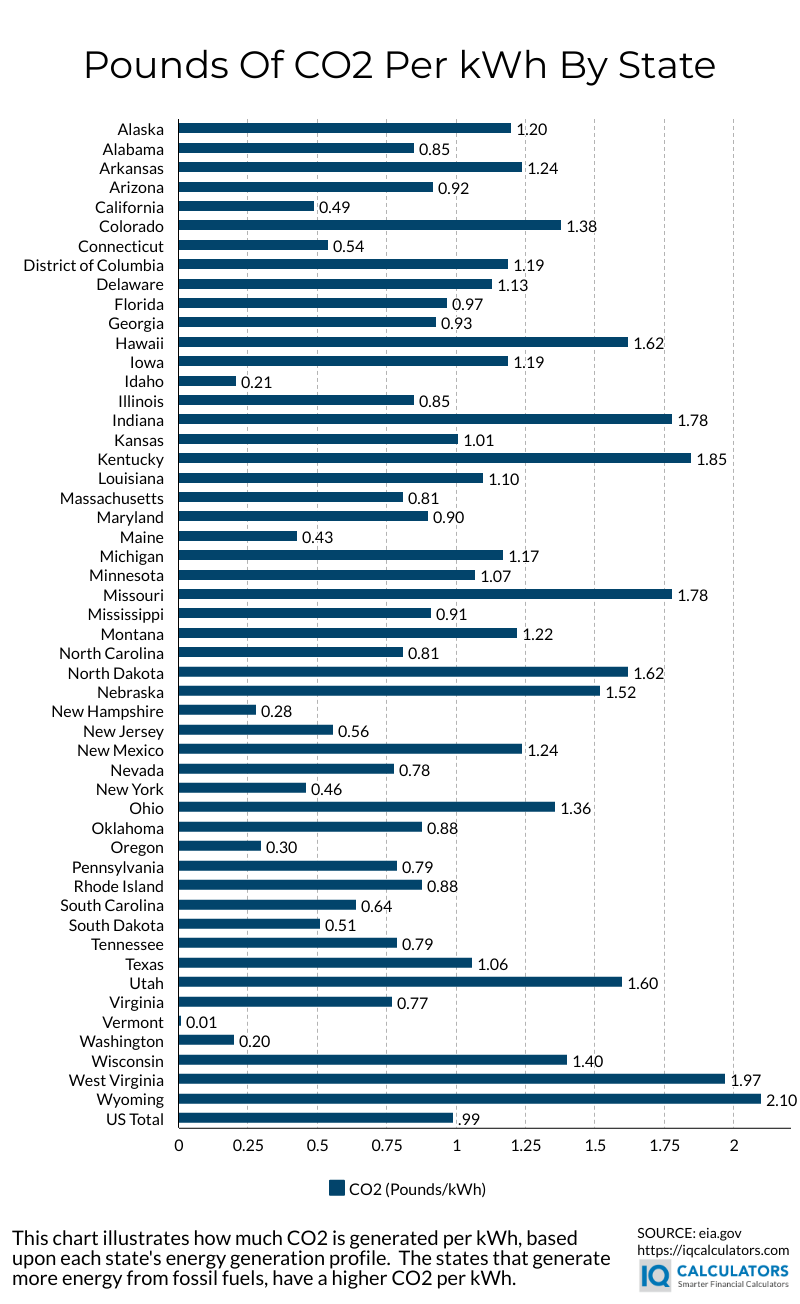
CO2 Comparison
To summarize, one gallon of gas in a motorcycle can take the motorcycle fifty miles but will create almost twenty pounds of CO2. One kWh of electricity can take a motorcycle 16.67 miles. To get kWh and gallons on an equivalent scale, 50 miles divided by 16.67 miles is a factor of about three. That means that 3 kWh can travel about as far as one gallon of gas. Each kWh creates one pound of CO2 equaling three pounds of CO2. That means that based on these assumptions, an electric motorcycle produces 3 pounds of CO2 for every 20 pounds of CO2 from a gas-powered motorcycle.
There's no arguing that an electric motorcycle will help motorcyclists emit fewer greenhouse gases. The environmental downside, which isn't completely understood yet, is that the chemicals from the batteries will potentially contaminate water and other parts of our environment as electric motorcycles and other vehicles become mainstream. But knowing that greenhouse gases are harmful, and not having enough data on the effects of battery contamination, it seems the environmental advantage is likely on the electric side.
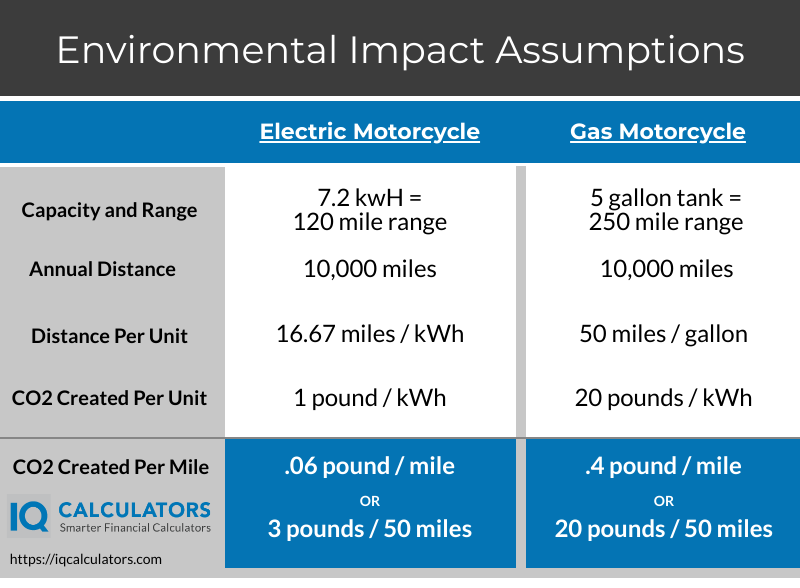
Financial Analysis
We've discussed some of the things that can't be measured. Now we are going to use a real-life example to evaluate the financial feasibility of owning an electric bike.
Financial Assumptions
For purposes of this illustration, we will assume that the average gas-powered bike can get 50 miles per gallon and can hold 5 gallons. Now let's say that an electric bike with a 7.2 kWh battery can travel 120 miles before needing to be recharged. That equals 16.67 miles per kWh. At the time of this writing, the average cost of a kWh is 14 cents. That means that it will cost about $1.05 for each charge. The average price of a gallon of gas at the time of this writing is $2.50. Taking $2.50 multiplied by 5 gallons equals $12.50 per refuel.
Travel
Let's assume that during one year, a person travels 10,000 miles, and those are all miles that are within range of an electric motorcycle. For the electric motorcycle, it will cost about $1.05 x (10,000 / 120) = 87.5 dollars/year. For the gas motorcycle, it will cost $12.50 x (10,000 / 25) = 500 dollars/year. That equates to an annual savings of 412 dollars. That is some impressive savings!
Maintenance
Looking at maintenance costs, we discussed previously that electric motorcycles have less maintenance than gas motorcycles. The average annual maintenance for a gas motorcycle is 750 to 1,000 dollars. Since there are fewer moving parts with electric motorcycles, the ordinary yearly maintenance for an electric motorcycle is 250 to 500 dollars. We will round up to the high end of the range in both cases -- five hundred dollars for electric motorcycles and one thousand dollars for gas motorcycles.
Motorcycle Prices
Now we come to a rather critical point. How much does a "middle of the road" average motorcycle cost in each category? For the electric motorcycle, we are going with the price of a Zero DS, which is a no-frills kind of bike that starts at eleven thousand dollars. A Zero DS is the kind of motorcycle that you can ride around town but probably won't want to ride on the highways very much. On the other hand, a regular gas-powered motorcycle of similar quality is going to cost around four thousand dollars.
Battery Replacement
One last factor to consider is how often an electric battery needs to get replaced. Some companies have 5-year unlimited mileage warranties on their batteries, such as Zero Motorcycle Company. Based on that, and with technology ever-improving, we will assume that a battery will need to get replaced every eight years. We think that is being generous, so feel free to be more conservative in your assumptions. And we are assuming that a battery will cost around 3,000 dollars.
Motorcycle Resale Prices
Running this scenario for ten years, we assume the motorcycles will each depreciate about 10 percent per year. That makes the resale value of the electric motorcycle about 4,000 dollars and the resale value of the gas motorcycle about 1,000 dollars creating a difference of 3,000 dollars.
Summary of Assumptions
We have made our assumptions. Here's a quick image that recaps our assumptions. Now let's do some analysis!
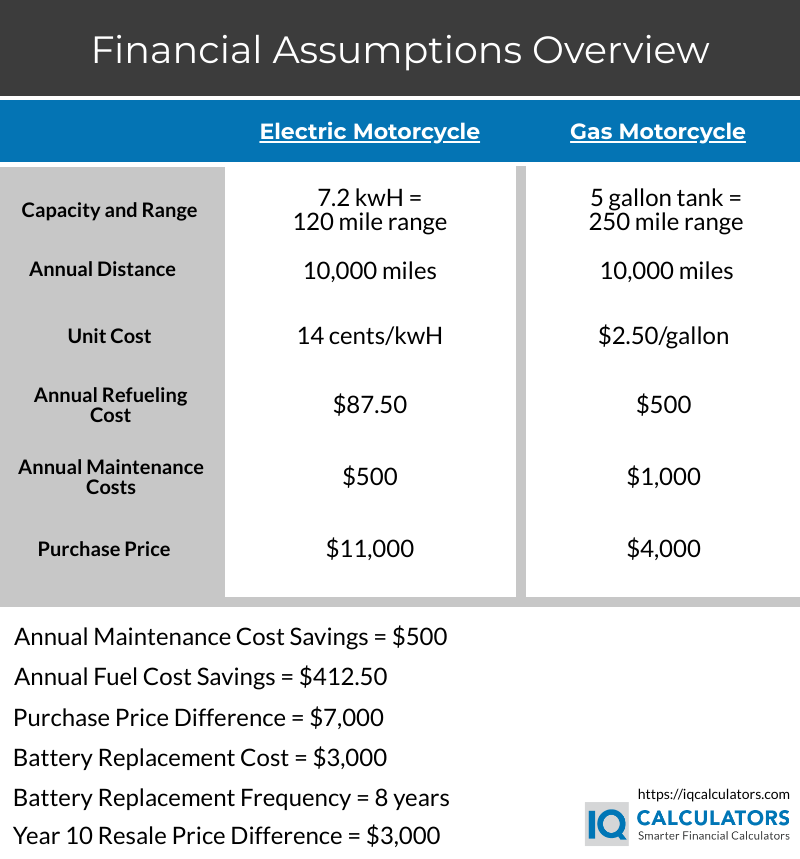
Based on these assumptions, we will save $912.50 per year in fuel and maintenance with an electric bike. We will assume these cost savings increase each year by 3 percent as the cost of gas increases. However, it will cost us $7,000 more to purchase, and we will need to replace the battery every eight years for 3,000 dollars.
IRR Cash Flow Analysis
We ran a 10-year cash flow analysis to calculate an IRR using an IRR calculator. You can see the results in the chart below.
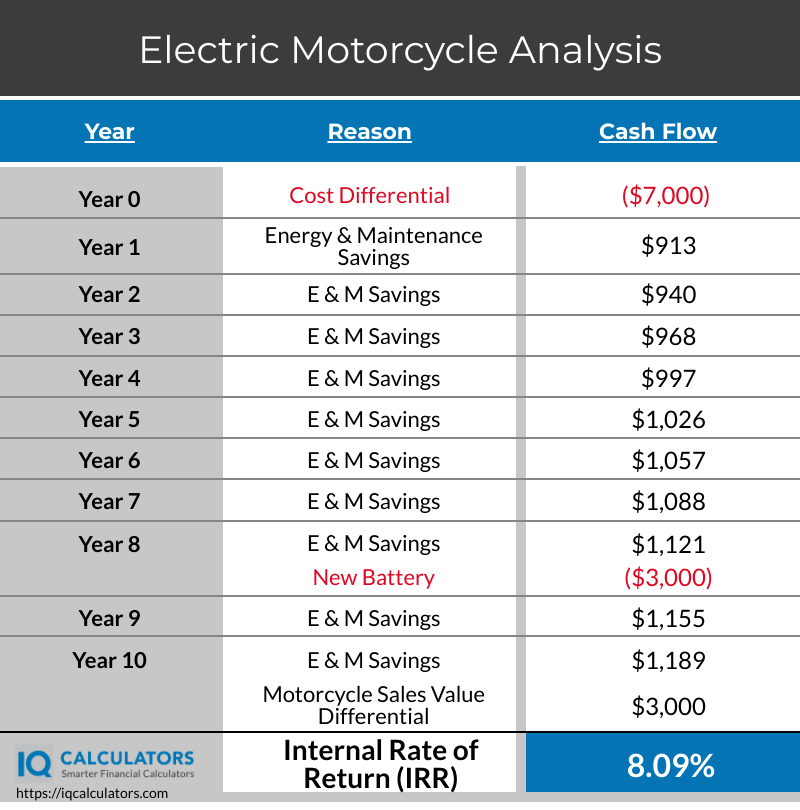
In another scenario, you could calculate a ten year IRR assuming that you purchase the motorcycle using a motorcycle loan. You would need to calculate the motorcycle loan payments for the electric and gas motorcycles and determine the difference between the two. The annual gap between payments would get factored into the cash flows.
Please remember, these assumptions are not factoring in any electric vehicle incentives as they vary from state to state. When doing your analysis, remember to look at the incentives offered in your state.
Conclusion
Economic assumptions are going to be unique to every person's situation. It's important to remember that assumptions are only assumptions. For example, in the scenario used above, what would happen if the person decides they are going to use the bike much less than 10,000 miles per year? If this were the case, it would change the entire scenario and thus the result. However, we hope these calculations can help form a reasonable baseline. To be able to do these calculations yourself, all you need to be able to do is estimate savings and use an IRR calculator.
If you aren't considering buying an electric bike for its financial benefits, then consider the qualitative list compiled above. We covered the general advantages and disadvantages of the two options. But regardless of these, the environmental impact may be the most significant factor in the decision. Only you know what the most critical factor is for you.
